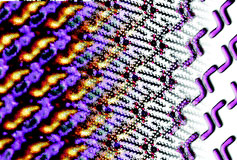Wednesday, 17 February, 2010
When molecules leave tire tracks
A new approach to optimizing molecular self-organization
Some classes of molecules are capable of arranging themselves in specific patterns on surfaces. This ability to self-organize is crucial for many technological applications, which are dependend on the assembly of ordered structures on surfaces. However, it has so far been virtually impossible to predict or control the result of such processes. Now a group of researchers led by Dr. Bianca Hermann, a physicist from the Center for Nanoscience (CeNS) at LMU Munich, reports a significant breakthrough: By combining statistical physics and detailed simulations with images obtained by scanning tunnelling microscopy (STM), the team has been able to formulate a simple model that can predict the patterns observed. With the help of the model, we can generate a wide variety of patterns that reproduce surprisingly well the arrangements observed experimentally, says Hermann. We want to extend this approach to other surface symmetries. Already now the areas of molecular electronics, sensor applications, surface catalysis and organic photovoltaics can profit from our model. Its ability to predict structures formed by self-organization allows optimization of molecular building blocks prior to synthesis. (NanoLetters online, 16 February 2010)
Press information LMU (english)
Presseinformation der LMU (deutsch)
Publication "Molecular Jigsaw: Pattern Diversity Encoded by Elementary Geometrical Features"


